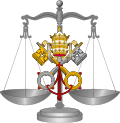Codes of Canon Law on religious institutes
On the basis of the distinction between solemn and simple vows, the 1917 Code of Canon Law made several other distinctions in relation to religious institutes, which it defined as legitimately established associations in accordance with which the members make public vows, either perpetual vows or temporary ones that are to be renewed periodically. It reserved the name "religious order" for institutes in which the vows were solemn, and used the term "religious congregation" for those with simple vows. The members of a religious order for men were called "regulars", those belonging to a religious congregation were simply "religious", a term that applied also to regulars. For women, those with simple vows were simply "sisters", with the term "nun" reserved in canon law for those who belonged to an institute of solemn vows, even if in some localities they were allowed to take simple vows instead. [20]
However, the 1917 Code abolished the distinction according to which solemn vows, unlike simple vows, were indissoluble. It recognized no totally indispensable religious vows and thereby abrogated for the Latin Church the special consecration that distinguished "orders" from "congregations", while keeping some juridical distinctions. [13]
A juridical distinction that the 1917 Code maintained was its declaring invalid any marriage attempted by solemnly professed religious or by those with simple vows to which the Holy See had attached the effect of invalidating marriage, [21] while stating that no simple vow rendered a marriage invalid, except in the cases in which the Holy See directed otherwise. [22] Thus solemnly professed religious were barred absolutely from marriage, and any marriage they attempted was invalid. Those who made simple vows were obliged not to marry, but if they did break their vow, the marriage was considered valid but illicit.
Another difference was that a professed religious of solemn vows lost the right to own property and the capacity to acquire temporal goods for himself or herself, but a professed religious of simple vows, while being prohibited by the vow of poverty from using and administering property, kept ownership and the right to acquire more, unless the constitutions of the religious institute explicitly stated the contrary. [23]
These were two of the nine juridical consequences (apart from spiritual effects) of the difference between solemn and simple vows. [8]
After publication of the 1917 Code, many institutes with simple vows appealed to the Holy See for permission to make solemn vows. The Apostolic Constitution Sponsa Christi of 21 November 1950 made access to that permission easier for nuns (in the strict sense), though not for religious institutes dedicated to apostolic activity. Many of these institutes of women then petitioned for the solemn vow of poverty alone. Towards the end of the Second Vatican Council, superiors general of clerical institutes and abbots president of monastic congregations were authorized to permit, for a just cause, their subjects of simple vows who made a reasonable request to renounce their property except for what would be required for their sustenance if they were to depart. [8]
The 1983 Code of Canon Law maintains the distinction between solemn and simple vows, [2] but no longer makes any distinction between their juridical effects. For instance, while under the 1917 Code solemn vows rendered a subsequent marriage invalid, but simple vows only made the marriage illicit, the current Code of Canon Law states that "those bound by a public perpetual vow of chastity in a religious institute invalidly attempt marriage". [24]
Renunciation of the right to own property is now a matter for the constitutions of the religious institute in question and is associated not with the solemnity of the vows but with their perpetuity. The 1983 Code states:
A person who must renounce fully his or her goods due to the nature of the institute is to make that renunciation before perpetual profession in a form valid, as far as possible, even in civil law; it is to take effect from the day of profession. A perpetually professed religious who wishes to renounce his or her goods either partially or totally according to the norm of proper law and with the permission of the supreme moderator is to do the same. A professed religious who has renounced his or her goods fully due to the nature of the institute loses the capacity of acquiring and possessing and therefore invalidly places acts contrary to the vow of poverty. Moreover, whatever accrues to the professed after renunciation belongs to the institute according to the norm of proper law. [25]


